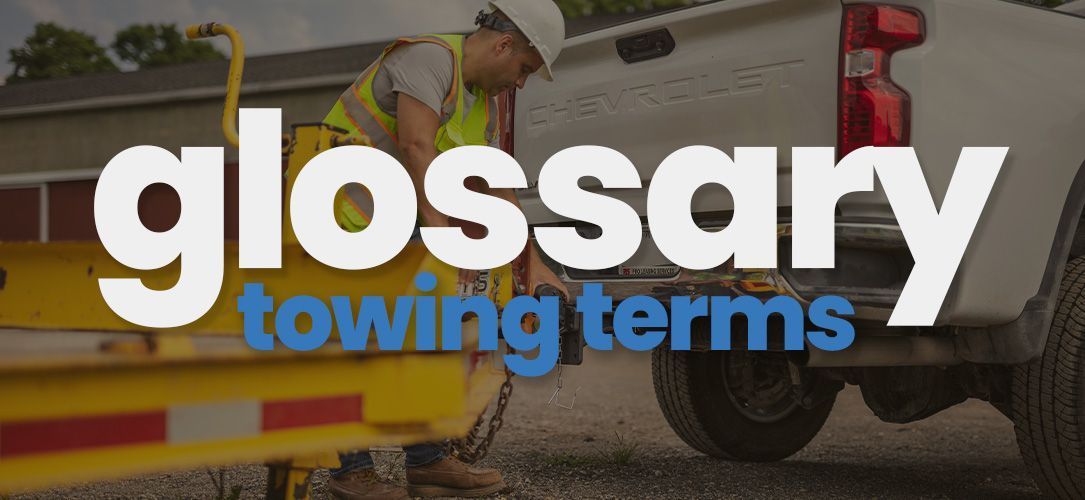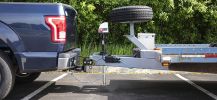A B C D E F G H I J K L M N O P Q R S T U V W X Y Z #
—A—
ACC
Adaptive Cruise Control
Aftermarket
Parts and accessories that fit a particular vehicle but are made by a manufacturer different than that of the original equipment manufacturer (OEM).
APV
All Purpose Vehicle
ATV
All Terrain Vehicle that typically uses handlebars for steering and has a straddled seating position like a motorcycle. An ATV is usually smaller than a UTV.
Auxiliary Power
A secondary power source used for and electrical function on a trailer other that exterior lighting and trailer brakes.
AWD
All Wheel Drive
Axle
Attaches wheels to the trailer
—B—
Ball Height
Measurement from the ground to the top of the ball or ball coupling when parked on a flat surface and parallel to the ground. Used to determine the amount of drop or rise needed I the ball mount to make the trailer ride parallel to the ground when being towed.
Ball Hole Size (hitch tube cover)
The receiver end cap that fits over the 1-1/4" or 2" receiver end of a hitch. Designed to protect the end from the elements and to give the hitch a finished look. There are many designer or logo covers available to enhance the look of your vehicle.
Ball Mount
The part of the trailer hitch that slides into a receiver and fastens with a pin and clip to allow the attachment of a ball for towing a trailer.
Bumper
the part of the vehicle which protects the front and rear end in the event of an accidents. The bumper should NEVER be used as a towing device.
Bumper types
-
Step: a bumper which is intended to be used as a step
-
Stock: original bumper on a vehicle (NOT a step bumper)
-
Cowboy: same as deep drop
-
Deep Drop: step bumper shaped like a “v” to lower the step surface in the center.
-
Roll pan: not really a bumper but a fascia panel used instead of bumper- common on lowered trucks.
-
OEM: comes on your vehicle from the factory- used when only one choice is available from the factory.
—C—
Cab & Chassis
A truck (usually commercial) that does not have a standard pickup bed, but comes from the factory with just a truck cab and frame rails (chassis). This type of truck will usually have a different width frame than a standard pickup with a pickup box.
Chassis
frame of vehicle. All other parts attach to regardless of whether it is unibody or frame construction.
-
Frame: all other parts attach to the frame and usually refers to a non-unibody chassis
-
Unibody: a vehicle that has frame and body integral. Usually has a sub-frame for the front end which mounts the engine and suspension.
Clip
Used to retain pin in receiver style hitch.
Coupler
The part of the trailer tongue that secures to the tow vehicle hitch ball.
Custom hitch
Hitch that is designed to fit a specific vehicle.
Cutaway Van Chassis
Incomplete vans that are used for service vehicles such as minibuses, ambulances and RV's.
—D, E—
Dinghy
A car or truck that is towed behind another, larger vehicle using a tow dolly or tow bar.
DOT
Department of Transportation
Drop-down
A ball mount with a drop in it to lower ball-height so trailer tows parallel to the ground.
Dry Weight
The weight of a vehicle or trailer as it comes from the factory, without any accessories, fluids, passengers or cargo.
Dually
A pickup truck with four tires on its rear axle (two on each side).
EV
Electric Vehicle
—F—
Fascia
Type of plastic trim and/or paneling that covers the bottom edges of some vehicles, usually in the front and rear. Trimming of fascia may be required for the installation of towing equipment such as a receiver hitch.
Fifth wheel Hitch
Type of hitch that mounts in the bed of a pickup truck that is designed to tow big tractor/trailer rigs. Uses a plate in the bed of the truck and a pin on the trailer.
Fish Wire
A special sized coiled wire that will thread on to a bolt and is "fished" through and enclosed frame or bumper to a point needed for hitch installation.
French link
A chain link with space, allowing chain to be attached to it. The space can be closed with an attached threaded collar, making the link once again integral.
FWD
Front Wheel Drive
—G—
GCVW
Gross Combined Vehicle Weight (GVW + weight of any towed vehicle or trailer)
Gooseneck Hitch
Trailer hitch which mounts in the bed of a pickup truck. Use a ball in the bed, and a coupler on the trailer (not to be confused with a fifth wheel)
Gross towing weight
The weight of the trailer plus all the cargo in it. This is measured by putting a fully loaded trailer on a scale.
GTW
Gross Towing Weight
GVW
Gross Vehicle Weight
—H—
Headache Rack (cab protectors)
Steel barriers behind the cab of a truck that protect drivers from shifting loads crashing into the cab.
Hitch/Hitch Application
Device that attaches to the chassis of a vehicle for towing.
In the industry, hitches are commonly called "hitch applications". This would refer to the specific hitch that would fit your specific vehicle.
Hitch Ball
The part that the trailer coupler attaches to. It is usually attached to a ball mount, which is inserted into the receiver end of a hitch.
Hitch Class
Rating system for trailer hitches that indicates the amount of weight they can safely tow.
-
Class I: hitch with capacity of up to 2,000lbs GTW and 200lb TW
-
Class II: hitch with capacity of up to 3,500lbs GTW and 350lb TW
-
Class III: hitch with capacity of up to 6,000lbs GTW and 600lb TW
-
Class IV: hitch with capacity of up to 12,000lbs GTW and 1,200lb TW
-
Class V: hitch with capacity of up to 18,0000lb GTW and 2,700lb TW (usually a 2.5” receiver or sometimes a 2” receiver)
Hitch Pin & Clip
The pin & clip are very important as they secure the receiver and the hitch or hitch accessory. The pin rests in the shank hole of the receiver and the clip fits over the head of the pin.
Hitch Shank Hole
The diameter of the opening in the ball mount for the hitch ball shank to go through. The hitch ball shank diameter and the ball mounts shank hole diameter should match.
—I, J—
ICC
Intelligent Cruise Control used by Nissan vehicles
Insert
Any item which slides into a receiver hitch (ball mount, bike rack, winch… etc)
ISR
Industry Standard Rails - Fifth wheel rails mounted above the bed of a truck with dimensions of 22" (front to back, center to center) x 3 choices of mounting slots of 10", 20-1/2" or 29" wide (center to center) for the mounting of a fifth wheel hitch or other towing equipment.
ITOR
Inside Top of Receiver (measurement from the ground to the upper inside edge of the receiver tube, used to help determine measurement for drop down or rise.
Jack Knife
Anytime the trailer tongue collides with the tow vehicle from turning too sharply. Usually occurs while backing up.
—L—
LB
Long Bed
Locking Hitch Pin
A hitch-pin which locks with a key to prevent theft of ball mount or other insert.
—O, P—
OEM
Original Equipment Manufacturer
PHEV
Plug-In Hybrid Electric Vehicle
Pin
Used to fasten any insert into a receiver hitch. Available in standard and locking configurations.
Pintle Hitch
tType of hitch that uses a round ring called a lunette on the trailer end. Sometimes referred to as a “GI” or military type hitch. Pintles have closing jaws, locking the lunette in.
Pintle Hitch Mount
Insert for a receiver, having a shank with a flat plate to bolt a pintle to. These are adjustable for vertical height.
Plug
The connector used to connect trailer wiring to the tow vehicle; plug refers to the trailer end of the connection, socket refers to the car end.
Powered Taillight Converter
The connector used to connect trailer wiring to the tow vehicle; plug refers to the trailer end of the connection, socket refers to the car end.
PWM System
More and more vehicles today use a PWM (pulse width modulation) system. Sometimes called a 'multiplex', this type of wiring is able to control multiple lighting functions through a single wire by varying the signal intensity. PWM systems can use incandescent or LED lights.
—R—
Receiver
The part of the trailer hitch that attaches to the frame of tow vehicle and has a receptacle which can take inserts such as ball mounts, bike racks, and other accessories.
RWD
Rear Wheel Drive
—S—
Safety Chains
Chains that are attached to the trailer tongue and have hooks on their free ends. They keep the trailer connected to the towing vehicle in the event the coupler or the hitch ball should come free.
SB
Short Bed
Shutters
Vanes in front of the radiator of a car or truck that open and close to control the temperature of the vehicles cooling system. Sometimes divided into upper and lower.
Socket
Wiring connector used on the CAR end of a trailer wiring connection. The plug is used on the trailer end.
Spring bar
The part of a weight distributing hitch which does the lifting. A “leveler” bar typically is made of spring steel.
Sub-frame
The part of the vehicle which supports the engine and front end suspension on a unibody vehicle.
Super Cruise
Hands free driving system in some cars and trucks.
Sway bar
A specialized spring which is part of the suspension on a vehicle. Not part of a trailer hitch- sometimes confused with a weight distributing hitch.
Sway control device
A device which goes between a weight distributing ball mount and a trailer to reduce the likelihood of sway caused by passing vehicle and wind. Should not be used to correct sway caused by improper tongue weight.
—T—
Tag-a-long trailer
Trailer that is pulled behind a vehicle with a chassis mounted trailer hitch as opposed to a fifth wheel or gooseneck.
Taillight Converter
Wiring converter- 5 wire systems to 4 wire systems. Used to integrate the stop circuit with the right and left circuits, with a diode on each circuit to prevent loopback to the turn signal switch...etc.
Tandem axle
Two axles (four wheels).
T-Connecter (Plug-in-Play Wire Harness)
This wiring is the easiest way to equip a vehicle with a trailer wiring connection. There are two types: harnesses and connectors. Both are made to be vehicle specific and install with no cutting or splicing.
Three Wire System
The three-wire system is the most common in the automotive industry. It sends the stop, taillight and turn signals along three separate wires. Vehicles with this system usually require a converter.
Tongue Weight
The downward force exerted on the ball by the trailer coupler.
Tow bar
Device that attaches to the front of the vehicle which allows it to be towed by another vehicle.
Trailer Coupler Lock
Similar to a locking hitch pin, it is placed onto the trailer coupler to prevent the theft of a trailer.
Trailer Tongue
This refers to the part of the trailer that extends forward from the trailer box and includes the coupler.
Tri-Axle
3 axles (6 wheels).
Trunnion
The replaceable end of a square bar weight distributing hitch which attaches to the ball mount.
TW
Tongue Weight
Two Wire System
The two-wire system is the simplest form of vehicle and trailer wiring and is still used by some vehicles today. This system sends the stop and turn signals along one wire, and the taillight signal along a second wire.
—U—
Universal hitch
No such thing- they do not exist. Some label them as such, but make compromises so that it fits “everything” and as a result fits nothing correctly.
UTV
Utility Task Vehicle or side-by-side that typically uses a steering wheel for steering and has individual bucket seats for each passenger. A UTV is usually larger that an ATV.
—V, W—
VIN
Vehicle Identification Number
WB
Wheel Base
WC
Weight Carrying
WD
Weight Distribution
Weight Carrying
A towing situation whereby all of the tongue weight is carried directly on the rear of the tow vehicle and on the hitch.
Weight Distributing
Towing situation when some or all of the tongue weight is redistributed by use of weight distribution attachment through the vehicles chassis from the rear axle to the front.
Working Load Limit
The amount of weight that a manufacturer says the product (rope, chain, strap, etc.) is safely rated to support.
—#—
4WD
Four Wheel Drive









